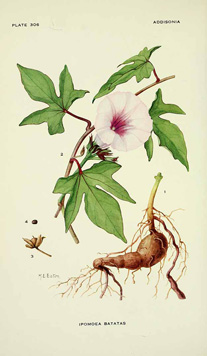I Yam Not a Yam:
Sweet Potato
By Audrey Stallsmith

What do you call a stolen yam? A hot potato!
Just when I thought I’d learned to distinguish orange-fleshed yams from white-fleshed sweet potatoes, I learned that both are actually sweet potatoes. Confused yet? I definitely was!
True yams (Dioscorea spp), also known as nyami, originated in Africa and Asia and are members of the lily family. Cylindrical in shape, they have a dark and rough skin which more closely resembles bark than a peel. Their flesh—ranging from white to purple—is less sweet, drier, and more starchy than that of the orange vegetable we call yam here in the U. S.
The latter actually is the softer form of sweet potato. Both forms originated in tropical areas of the Americas and are supposed to have been introduced into the rest of the world by Columbus. However, they were present in Polynesia long before “Columbus sailed the ocean blue,” so they may have been indigenous there too.
Unlike true yams, they are smooth to the touch with tapered ends. Those with tan skin and pale flesh generally are not as soft and sweet as the copper-skinned orange varieties. All, however, are classified as Ipomoea batatas and are members of the morning glory family. Some cultivars can even produce pink or violet, morning-glory like blooms in tropical climates.
Ipomoea comes from the Greek ips (“worm”) and homois (“resembling”), probably in reference to the plants’ wriggly vining habit, which can extend to about 10 feet. Batata is a Caribbean name for the vegetable and probably the word from which “potato” derived. However, the sweet kind aren’t very closely related to the more common variety, Solanum tuberosum. Although it also originated in South America, it belongs to the nightshade family.
Now that we have almost enough families to stock a small village, we can conclude that—erroneously named or not—sweet potatoes still have become a highly popular crop in the warmer regions of the world. We northerners are more likely to eat them at holidays, though how a southern vegetable came to be associated with the Pilgrims is beyond me.
At any rate, sweet potatoes are very good for us, being high in beta carotene, Vitamin C, and antioxidants and helping to lower blood sugar. And, when your highly annoying cousin Wilfred calls them yams at the Thanksgiving table, you can oh-so-sweetly correct him.
Ipomoea batatas image is by M. E. Eaton from Addisonia, Vol. 9, courtesy of plantillustrations.org.








